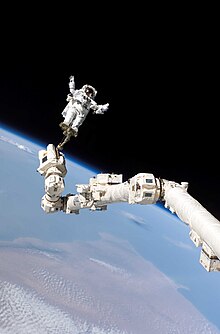Stephen Robinson
| Stephen Robinson | |
|---|---|
 | |
| NASA Astronaut | |
| Statsborger | USA |
| Nationalitet | |
| Status | Aktiv |
| Født | 26. oktober 1955 (65 år) Sacramento, USA |
| Uddannelses- sted | University of California, Davis Stanford University Campolindo High School |
Tid i rummet | 34 dage 15 timer 44 minutter |
| Udvælgelse | NASA-gruppen fra 1994 |
| Mission(er) | STS-85, STS-95, STS-114, STS-130 |
| Missionsemblemer | |

Stephen Kern Robinson (født 26. oktober 1955) er en amerikansk NASA-astronaut,
Han begyndte at arbejde for NASA i 1975 som studerendepraktikant.
I 2010 var han med som missionsspecialist og flyvemaskinistcertifikat på STS-130.
Eksterne henvisninger
| Spire Denne biografi om en amerikaner er en spire som bør udbygges. Du er velkommen til at hjælpe Wikipedia ved at udvide den. |
Medier brugt på denne side

- The blue Shuttle rising above Earth's horizon includes the Columba constellation of seven stars, echoing the Columbia STS-107 patch and commemorating those seven crewmembers. The dominant element of the patch is the Earth, representing the unity and dedication of the many people whose efforts allow the Shuttle to return safely to flight. Against the nighttime Earth, the blue orbit represents the International Space Station, with the Shuttle crew spacewalk team named on the orbit. The red sun as the O in Noguchi signifies the contributions of the Japan Aerospace Exploration Agency to the mission and to the ISS program. The multi-colored Shuttle plume represents the spectrum of challenges for this mission, including Shuttle inspection and repair experiments, International Space Station resupply and repair, and testing of new safety procedures.
The STS-95 patch, designed by the crew, is intended to reflect the scientific, engineering, and historic elements of the mission. The Space Shuttle Discovery is shown rising over the sunlit Earth limb, representing the global benefits of the mission science and the solar science objectives of the Spartan Satellite. The bold number '7' signifies the seven members of Discovery's crew and also represents a historical link to the original seven Mercury astronauts. The STS-95 crew member John Glenn's first orbital flight is represnted by the Friendship 7 capsule. The rocket plumes symbolize the three major fields of science represented by the mission payloads: microgravity material science, medical research for humans on Earth and in space, and astronomy.
Astronaut Stephen K. Robinson, STS-114 mission specialist, anchored to a foot restraint on the International Space Station’s Canadarm2, participates in the mission’s third session of extravehicular activity (EVA). The blackness of space and Earth’s horizon form the backdrop for the image.
The mission patch for STS-85 is designed to reflect the broad range of science and engineering payloads on the flight. The primary objectives of the mission were to measure chemical constituents in Earth's atmosphere with a free-flying satellite and to flight-test a new Japanese robotic arm designed for use on the International Space Station (ISS). STS-85 was the second flight of the satellite known as Cryogenic Infrared Spectrometers and Telescopes for the Atmosphere-Shuttle Pallet Satellite-2 CRISTA-SPAS-02. CRISTA, depicted on the right side of the patch pointing its trio of infrared telescopes at Earth's atmosphere, stands for Cryogenic Infrared Spectrometers and Telescopes for the Atmosphere. The high inclination orbit is shown as a yellow band over Earth's northern latitudes. In the Space Shuttle Discovery's open payload bay an enlarged version of the Japanese National Space Development Agency's (NASDA) Manipulator Flight Demonstration (MFD) robotic arm is shown. Also shown in the payload bay are two sets of multi-science experiments: the International Extreme Ultraviolet Hitchhiker (IEH-02) nearest the tail and the Technology Applications and Science (TAS-01) payload. Jupiter and three stars are shown to represent sources of ultraviolet energy in the universe. Comet Hale-Bopp, which was visible from Earth during the mission, is depicted at upper right. The left side of the patch symbolizes daytime operations over the Northern Hemisphere of Earth and the solar science objectives of several of the payloads.
Astronaut Stephen K. Robinson, mission specialist
The official patch for STS-130. The shape of the patch represents the Cupola, which is the windowed robotics viewing station, from which astronauts will have the opportunity not only to monitor a variety of ISS operations, but also to study our home planet. The image of Earth depicted in the patch is the first photograph of the Earth taken from the moon by Lunar Orbiter I on August 23, 1966. As both a past and a future destination for explorers from the planet Earth, the moon is thus represented symbolically in the STS-130 patch. The Space Shuttle Endeavour is pictured approaching the ISS, symbolizing the Space Shuttle's role as the prime construction vehicle for the ISS.







